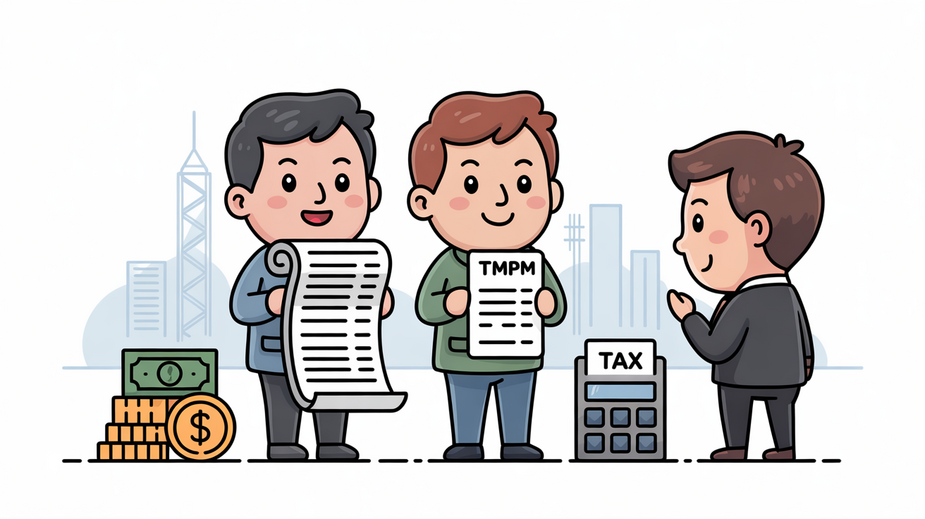
Understanding Temporary vs. Permanent Employment and Its Tax Implications in Hong Kong
📋 Key Facts at a Glance
- Continuous Contract Rule: The “4/18 rule” (4 consecutive weeks, 18+ hours/week) determines statutory employment rights, but proposed changes may introduce a “4/68 rule” (4 weeks, 68+ total hours)
- Salaries Tax Rates: Progressive rates from 2% to 17%, or standard rate of 15% on first HK$5 million and 16% above that (2024-25)
- Key Deductions: MPF contributions (max HK$18,000/year), home loan interest (max HK$100,000), domestic rent (max HK$100,000), and qualifying annuity/voluntary MPF (max HK$60,000)
Are you hiring temporary staff or considering a short-term contract in Hong Kong? Understanding the distinction between temporary and permanent employment isn’t just about job security—it directly impacts your tax obligations, statutory benefits, and legal compliance. With Hong Kong’s workforce evolving and tax regulations constantly updating, getting this classification right could save you from significant financial penalties and ensure you’re maximizing available tax benefits.
The Fundamental Difference: Temporary vs. Permanent Employment
In Hong Kong’s dynamic labor market, the line between temporary and permanent employment goes beyond just contract duration. While permanent positions typically offer open-ended arrangements with long-term stability, temporary roles are defined by fixed terms, specific projects, or short-term needs. However, what truly matters for legal and tax purposes is whether an employee qualifies under Hong Kong’s “continuous contract” rules.
The Game-Changer: Continuous Contract Status
The Employment Ordinance’s “continuous contract” concept is the critical factor that transforms temporary arrangements into permanent-like employment relationships. Currently, the “4/18 rule” applies: an employee who works for the same employer for at least four consecutive weeks, with a minimum of 18 hours worked each week, automatically gains continuous contract status.
| Feature | Temporary Employment | Permanent Employment |
|---|---|---|
| Contract Duration | Fixed term or project-based | Indefinite or continuous |
| Typical Benefits | Often limited or pro-rata based on contract terms | Standard benefits (MPF, comprehensive leave, medical, etc.) |
| Continuous Contract Status | Can apply after meeting 4/18 rule, activating statutory rights | Typically applies from commencement if hours/duration met |
Tax Implications: How Employment Type Affects Your Tax Bill
Whether you’re a permanent employee or temporary contractor, Hong Kong’s tax system treats employment income under Salaries Tax. However, the specific rates, deductions, and reporting requirements can vary significantly based on your employment classification and residency status.
Salaries Tax Rates for 2024-2025
All employees in Hong Kong—whether temporary or permanent—are subject to Salaries Tax on their employment income. The system offers two calculation methods:
- Progressive Rates: Applied to net chargeable income after deductions and allowances:
- First HK$50,000: 2%
- Next HK$50,000: 6%
- Next HK$50,000: 10%
- Next HK$50,000: 14%
- Remainder: 17%
- Standard Rate: 15% on first HK$5 million, 16% on amount exceeding HK$5 million
Key Tax Deductions and Allowances
Both temporary and permanent employees can claim these valuable deductions and allowances for the 2024-25 tax year:
- MPF Contributions: Maximum HK$18,000 per year
- Home Loan Interest: Maximum HK$100,000 (available for up to 20 years)
- Domestic Rent: Maximum HK$100,000
- Qualifying Annuity/Voluntary MPF: Maximum HK$60,000
- Charitable Donations: Maximum 35% of assessable income
- Self-education Expenses: Maximum HK$100,000
| Tax Aspect | Permanent Employee | Temporary/Short-term Staff |
|---|---|---|
| Primary Tax System | Progressive Salaries Tax | Progressive Salaries Tax (Residents), potentially Flat Rate (Non-residents on short engagements) |
| Key Deductions Available | Standard employment deductions (MPF, allowances, etc.) | Generally eligible for standard employment deductions on relevant income earned in HK |
| Typical Filing Procedure | Standard annual Salaries Tax return (BIR60) | Standard annual return for residents; specific notification/clearance for non-residents on short-term work |
The Hidden Danger: Risks of Worker Misclassification
Incorrectly classifying employees as temporary contractors or independent workers is one of the most costly mistakes businesses can make in Hong Kong. The consequences extend far beyond administrative errors—they can trigger substantial financial liabilities and legal penalties.
Financial Consequences of Misclassification
- Retrospective Claims: Employers could be liable for back payments covering wages, statutory leave pay, and MPF contributions dating back several years
- Tax Penalties: The IRD can impose interest on underpaid taxes at 8.25% (from July 2025) plus additional penalties
- MPF Surcharges: Late MPF contributions attract 5% surcharge on overdue amounts plus interest
- Employment Ordinance Violations: Fines for failing to provide statutory benefits to continuous contract employees
Practical Scenarios: Real-World Tax Outcomes
Let’s examine how different employment arrangements play out in Hong Kong’s tax landscape through practical examples:
| Scenario | Employment Type | Key Tax Considerations |
|---|---|---|
| Temporary Contractor (Multiple Clients) | Temporary / Potentially Self-employed | Income aggregation & source; Business vs. Employment income classification; Claiming business expenses vs. standard personal allowances |
| Permanent Employee (Receiving Housing Benefit) | Permanent (Resident) | Taxability of housing benefit; Eligibility for housing deductions (mortgage interest up to HK$100,000 or domestic rent up to HK$100,000) |
| Cross-Border Worker | Temporary or Permanent (Resident/Non-resident) | Tax residency determination; Application of Hong Kong’s 45+ double taxation agreements; Split income reporting based on work location |
Cross-Border Employment Considerations
For employees working across borders, Hong Kong’s extensive network of Double Taxation Agreements (DTAs) with over 45 jurisdictions becomes crucial. These agreements help prevent double taxation and clarify where tax liabilities arise. Key considerations include:
- Tax Residency Certificates: Essential for claiming DTA benefits
- 183-Day Rule: Many DTAs use this threshold to determine taxing rights
- Split-Year Treatment: For employees moving in/out of Hong Kong during the tax year
- Foreign Tax Credits: Available to avoid double taxation on the same income
Compliance Strategies for Employers
Implementing robust compliance strategies is essential for managing diverse workforces while minimizing tax risks:
- Regular Employment Status Audits: Review workforce classifications quarterly against Employment Ordinance criteria and IRD guidelines
- Accurate Record-Keeping: Maintain detailed records for 7 years (the statutory retention period), including engagement dates, remuneration details, and tax deductions
- Proactive MPF Management: Ensure timely contributions for all eligible employees, including those on temporary contracts meeting the 60-day employment threshold
- Clear Contract Documentation: Use precise language in employment contracts that accurately reflects the working relationship
- Stay Updated on Legislative Changes: Monitor proposed changes to continuous contract rules and other employment regulations
The Future of Work and Tax Implications
Hong Kong’s workforce is evolving with global trends, presenting new challenges for tax compliance:
| Trend | Tax Compliance Challenge | Adaptation Strategy |
|---|---|---|
| Gig Economy Growth | Diverse income sources, accurate worker classification, self-reporting compliance | Implement clear contractor guidelines, use digital platforms for income tracking |
| Hybrid/Remote Work Expansion | Determining tax residency, applying source rules to cross-border work | Leverage Hong Kong’s DTAs, maintain detailed work location records |
| Technology Adoption | Handling complex income structures, frequency of income flow | Use automated payroll systems, implement digital tax filing tools |
✅ Key Takeaways
- Continuous contract status (4/18 rule) determines statutory employment rights, not just contract labels
- All employment income in Hong Kong is subject to Salaries Tax, with progressive rates (2%-17%) or standard rate (15%-16%)
- Misclassification risks include back payments, MPF surcharges, and tax penalties with 6-10 year look-back periods
- Both temporary and permanent employees can claim valuable deductions like MPF contributions (HK$18,000 max) and housing expenses (HK$100,000 max)
- Hong Kong’s 45+ double taxation agreements are crucial for cross-border employment arrangements
Navigating Hong Kong’s employment classification and tax landscape requires careful attention to both the Employment Ordinance and tax regulations. Whether you’re an employer structuring your workforce or an employee understanding your rights, the key is recognizing that temporary versus permanent is more than just contract duration—it’s about statutory rights, tax obligations, and compliance requirements. With proposed changes to continuous contract rules and evolving work patterns, staying informed and seeking professional advice when needed will help ensure you remain compliant while optimizing your tax position in Hong Kong’s dynamic business environment.
📚 Sources & References
This article has been fact-checked against official Hong Kong government sources and authoritative references:
- Inland Revenue Department (IRD) – Official tax rates, allowances, and regulations
- Rating and Valuation Department (RVD) – Property rates and valuations
- GovHK – Official Hong Kong Government portal
- Legislative Council – Tax legislation and amendments
- IRD Salaries Tax Guide – Official salaries tax rates and deductions
- Labour Department – Employment Ordinance and continuous contract rules
- GovHK MPF Deductions – Official MPF contribution deduction guidelines
Last verified: December 2024 | Information is for general guidance only. Consult a qualified tax professional for specific advice.



